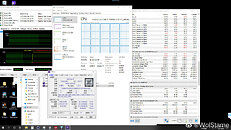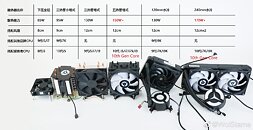- Joined
- Oct 9, 2007
- Messages
- 47,783 (7.41/day)
- Location
- Dublin, Ireland
| System Name | RBMK-1000 |
|---|---|
| Processor | AMD Ryzen 7 5700G |
| Motherboard | Gigabyte B550 AORUS Elite V2 |
| Cooling | DeepCool Gammax L240 V2 |
| Memory | 2x 16GB DDR4-3200 |
| Video Card(s) | Galax RTX 4070 Ti EX |
| Storage | Samsung 990 1TB |
| Display(s) | BenQ 1440p 60 Hz 27-inch |
| Case | Corsair Carbide 100R |
| Audio Device(s) | ASUS SupremeFX S1220A |
| Power Supply | Cooler Master MWE Gold 650W |
| Mouse | ASUS ROG Strix Impact |
| Keyboard | Gamdias Hermes E2 |
| Software | Windows 11 Pro |
As if reports of Intel's latest mobile flagship Core i9-10980HK pulling up to 135 W power in short bursts to achieve its 5.30 GHz Thermal Velocity Boost (TVB) frequency weren't bad enough, it appears like the 10th generation Core desktop processors won't win Intel any prizes in the energy efficiency contests. According to tech Tweeter "@9550Pro," citing Chinese enthusiast @Wolstame, with a reasonably high hit-rate with tech rumors, Intel's upcoming Core i9-10900F processor can pull up to 224 Watts of power. The i9-10900F isn't even an unlocked chip like i9-10900K, but rather an iGPU-disabled version of the locked i9-10900.
The i9-10900F 10-core/20-thread processor allegedly has its PL1 value set at 170 W, and PL2 at 224 W. The latter is probably needed to give the chip's TVB algorithm power headroom to achieve either the chip's 5.30 GHz TVB max frequency, or its maximum all-core boost frequency of 4.50 GHz. The latter could be Intel's strategy to take on AMD's Ryzen 9 3900X and 3950X in multi-threaded benchmarks (run 10 cores at 4.50 GHz). Intel is possibly looking to price the i9-10900 series (i9-10900F, i9-10900, i9-10900KF, and i9-10900K) at price-points ranging between $450-500, if not more. With these power-draw figures, it's all but certain that Intel could recommend serious cooling solutions for the i9-10900 series, at least a 240 mm x 120 mm AIO. AMD recommends a 280 mm x 140 mm AIO for the 16-core 3950X.


View at TechPowerUp Main Site
The i9-10900F 10-core/20-thread processor allegedly has its PL1 value set at 170 W, and PL2 at 224 W. The latter is probably needed to give the chip's TVB algorithm power headroom to achieve either the chip's 5.30 GHz TVB max frequency, or its maximum all-core boost frequency of 4.50 GHz. The latter could be Intel's strategy to take on AMD's Ryzen 9 3900X and 3950X in multi-threaded benchmarks (run 10 cores at 4.50 GHz). Intel is possibly looking to price the i9-10900 series (i9-10900F, i9-10900, i9-10900KF, and i9-10900K) at price-points ranging between $450-500, if not more. With these power-draw figures, it's all but certain that Intel could recommend serious cooling solutions for the i9-10900 series, at least a 240 mm x 120 mm AIO. AMD recommends a 280 mm x 140 mm AIO for the 16-core 3950X.


View at TechPowerUp Main Site







